To set up a productive home office, choose a well-lit, quiet spot near a window to reduce eye strain and boost mood. Use ergonomic furniture like adjustable chairs and proper desks to support good posture. Keep your space organized with clear zones and storage, minimizing clutter. Add personal touches such as plants or photos for comfort. Focus on good lighting, ventilation, and routines to stay on track. If you continue exploring, you’ll discover strategies to boost your efficiency even further.
Key Takeaways
- Choose a well-lit, quiet space near natural light with minimal distractions.
- Use ergonomic furniture and organize essentials to promote comfort and efficiency.
- Incorporate personal decor and motivational items to create an inviting environment.
- Implement effective lighting, ventilation, and noise management techniques.
- Establish routines and task prioritization methods to enhance focus and productivity.
Choosing the Ideal Location for Your Workspace
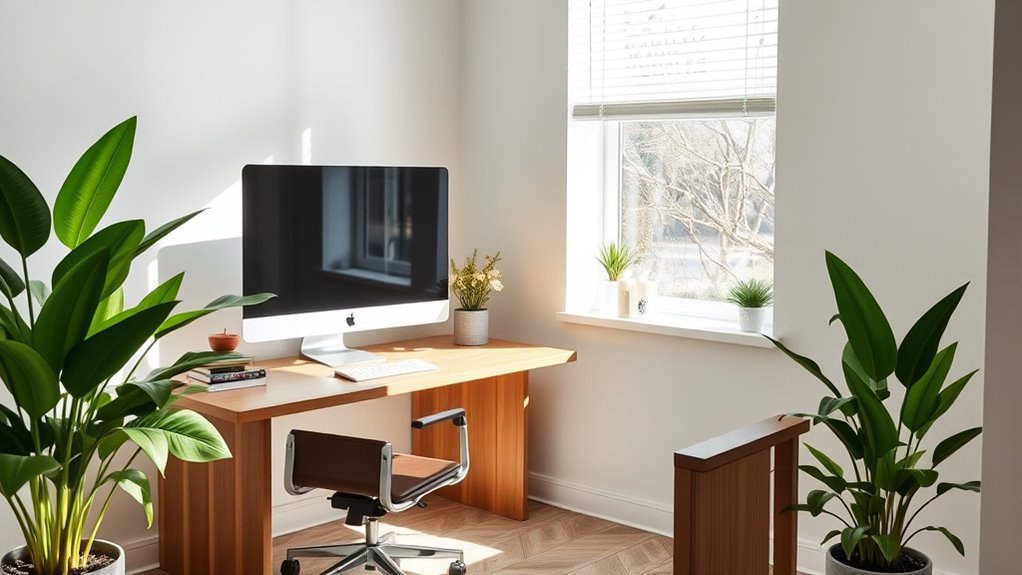
Selecting the right location for your home office is essential for maintaining focus and productivity. You want a spot with ample natural lighting, which boosts your mood and reduces eye strain. Choose a space with close proximity to a window to maximize sunlight during the day. Natural light creates a more inviting environment, helping you stay alert and energized. Avoid areas with distractions or high foot traffic, as they can interrupt your workflow. Position your workspace where you can easily access your essentials without cluttering your area. Remember, a well-lit, quiet spot near a window sets the tone for an efficient workday, making it easier to stay motivated and focused on your tasks. Considering environmental considerations can also help you select a space that supports sustainability and comfort.
Ergonomic Furniture and Equipment Essentials
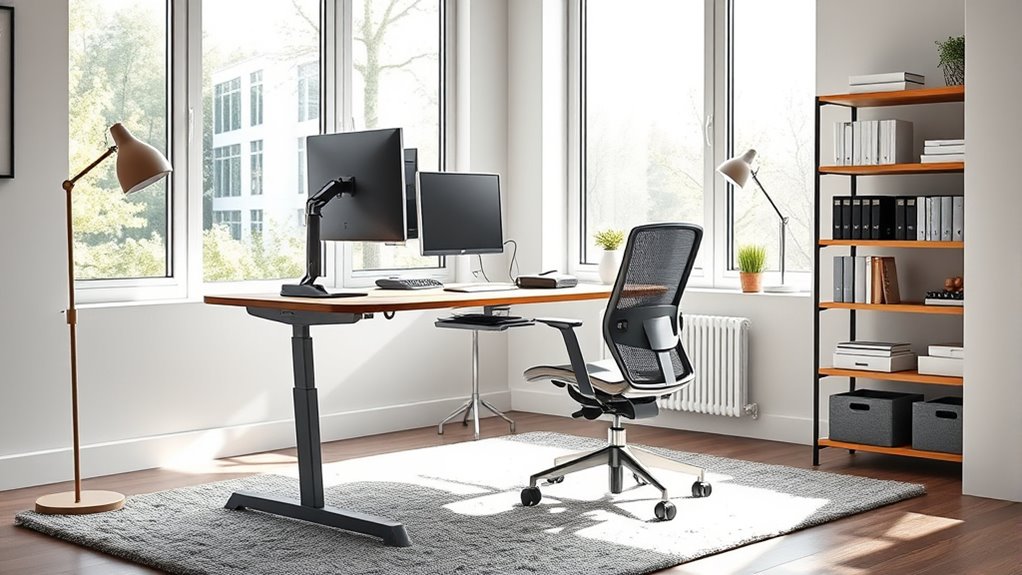
To work comfortably and prevent strain, investing in ergonomic furniture and equipment is vital. An adjustable chair allows you to customize height and lumbar support, promoting proper posture throughout your workday. This helps reduce back and neck pain, making long hours more manageable. Pair your chair with an ergonomic keyboard designed to minimize wrist strain and improve typing comfort. Look for models with a slight negative tilt and cushioned keys. Ensuring your desk setup promotes a natural arm position is essential for avoiding repetitive stress injuries. Additionally, consider a footrest if your feet don’t rest flat on the ground. Incorporating local health initiatives can also provide guidance on ergonomic best practices for a healthier workspace. These essentials create a healthier workspace, boost productivity, and help you work more comfortably for extended periods.
Organizing Your Office for Maximum Efficiency
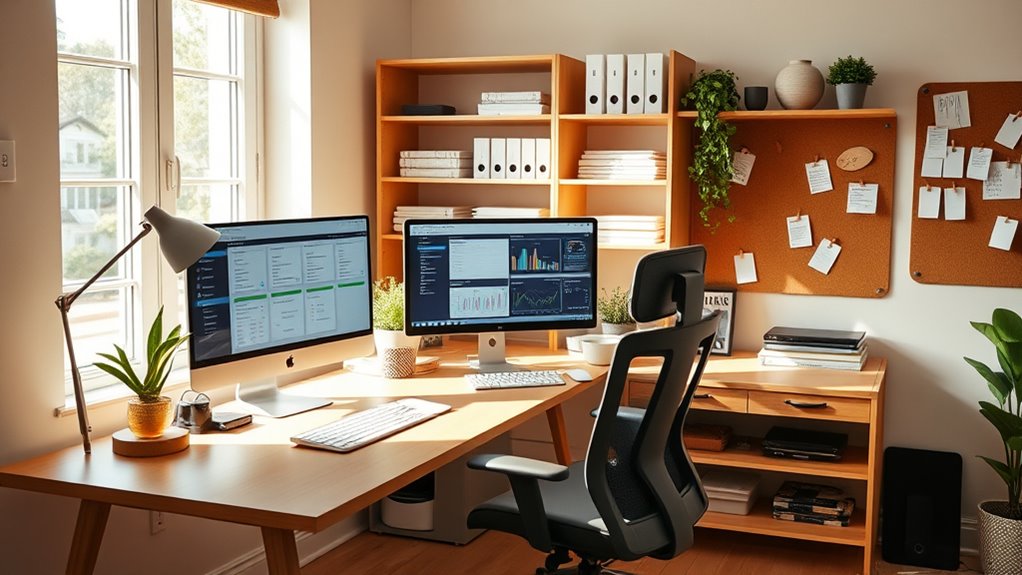
To work efficiently, you need to keep your workspace clutter-free and organized. Use smart storage solutions to keep supplies within reach and free up surface space. Clearly define zones for different tasks to stay focused and avoid unnecessary distractions. Incorporating best organization practices can further enhance your home office setup for maximum productivity.
Declutter Your Workspace
A cluttered workspace can hinder your productivity and increase stress, making it essential to organize your office effectively. Start by clearing unnecessary items and focusing on essentials. Use proper file organization to keep important documents easily accessible and avoid piles of paper. Tackle cable management by bundling cords with clips or sleeves to prevent tangles and reduce visual clutter. Keep your desk surface clear, leaving only your most-used items within reach. Regularly reassess your space to remove items you no longer need. This not only creates a cleaner environment but also helps you focus better. An organized workspace minimizes distractions and streamlines your workflow, allowing you to work more efficiently and feel more in control of your environment. Incorporating wall organization systems can also enhance overall room design and functionality.
Optimize Storage Solutions
Effective storage solutions are essential for maintaining an organized and efficient home office. Vertical storage maximizes space by utilizing wall height, freeing up valuable surface areas. Install tall cabinets or wall-mounted shelves to keep items off your desk and within easy reach. Modular shelving offers flexible organization, allowing you to customize your storage system as your needs change. Use these shelves for books, supplies, or decorative items to reduce clutter and improve accessibility. Combining vertical storage with modular shelving creates a streamlined setup that keeps everything you need close at hand. Make sure to label storage bins and categorize items to find what you need quickly. A well-organized space boosts productivity and makes your home office a more pleasant environment. Additionally, incorporating storage organization strategies can further enhance your workspace efficiency.
Establish Clear Zones
Creating distinct zones within your home office helps you work more efficiently and reduces distractions. Designating work zones allows you to separate tasks, such as setting up a dedicated area for focused work, meetings, or creative projects. When you establish clear boundaries, your mind associates each zone with specific activities, boosting productivity. Integrate technology thoughtfully by positioning your computer, printer, and charging stations strategically within these zones. This minimizes clutter and streamlines your workflow. Consider using furniture or visual cues, like rugs or shelves, to differentiate spaces. Keeping each zone organized ensures you stay on task and avoid the temptation of multitasking in the wrong area. Clear zones create a purposeful environment that enhances focus, efficiency, and overall work satisfaction. Regularly assess and rotate items within your space to prevent clutter buildup and maintain optimal organization.
Enhancing Lighting and Ventilation
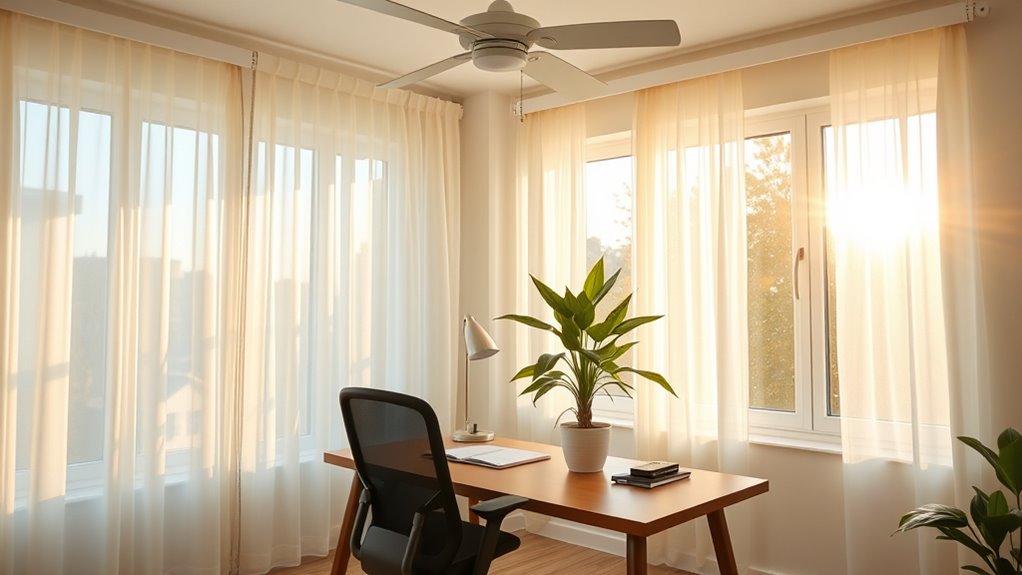
Improving lighting and ventilation in your home office can substantially boost your comfort and productivity. Maximizing natural light helps reduce eye strain and keeps you alert throughout the day. Position your desk near windows or use sheer curtains to let in ample sunlight while minimizing glare. Good air quality is equally important; ensure your space is well-ventilated by opening windows regularly or using an air purifier. Fresh air refreshes your mind and prevents stuffiness, which can drain your focus. Incorporate adjustable lighting options to adapt to different tasks and times of day. Proper airflow and natural light create a healthier, more inviting environment, helping you stay energized and motivated during your work hours. Additionally, ensuring adequate contrast with appropriate lighting can improve screen visibility and reduce eye fatigue.
Incorporating Personal Touches to Boost Morale

Adding personal touches to your home office can considerably boost your morale and make the space feel more inviting. When you incorporate personal decor and motivational posters, you create an environment that energizes and inspires you. To make your workspace uniquely yours, consider adding items like:
- Framed photos of loved ones or pets
- Inspirational quotes or artwork
- A cozy throw blanket or decorative pillows
- Plants to add freshness and color
- A bulletin board for notes and achievements
These touches not only personalize your space but also foster a positive mindset. Motivational posters, in particular, serve as daily reminders of your goals and boost your motivation. Incorporating interior design principles can further improve the functionality and aesthetics of your workspace. Small, meaningful updates can make your home office a more enjoyable and uplifting environment.
Managing Distractions and Staying Focused
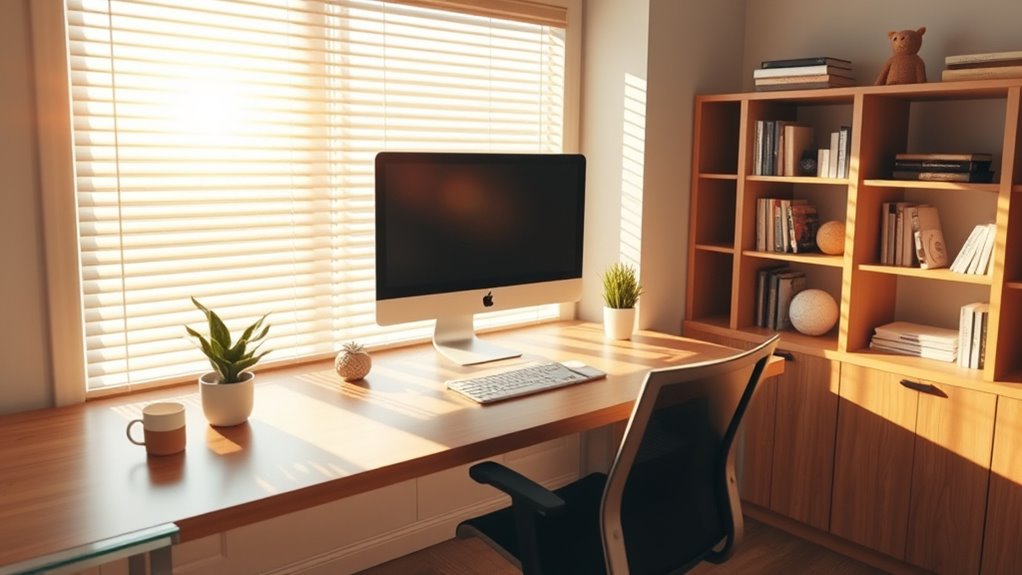
To stay focused, you need to minimize noise disruptions and set clear boundaries for your workspace. Prioritize your tasks so you can tackle the most important ones first without getting overwhelmed. By managing these aspects, you’ll find it easier to maintain your concentration throughout the day. Incorporating performance upgrades can also boost your productivity by creating a more efficient environment.
Minimize Noise Disruptions
Noise disruptions can profoundly hinder your focus, especially if your home environment isn’t naturally quiet. To minimize these distractions, consider implementing soundproofing techniques like sealing gaps around doors and windows or adding thick curtains. Use noise canceling devices such as headphones or earbuds to block out background sounds effectively. Additionally, position your workspace away from noisy areas like kitchens or busy hallways. Creating a designated quiet zone signals to others that you need uninterrupted time. You can also try white noise machines or calming background music to mask disruptive noises. These strategies help maintain your concentration and boost productivity. Incorporating soundproofing methods can further improve your environment by reducing external noise intrusion. Prioritizing sound control guarantees your home office remains a peaceful space where you can work efficiently without constant interruptions.
Establish Clear Boundaries
Establishing clear boundaries is essential for minimizing distractions and maintaining focus in your home office. Boundary setting helps define when you’re working and when you’re off-duty, which is vital for a healthy work life balance. Communicate your work hours to family or housemates, so they understand when you shouldn’t be disturbed. Use physical cues like a closed door or a designated workspace to signal your focus time. Avoid mixing household chores or personal errands with work tasks, as blurring these lines can reduce productivity. By setting firm boundaries, you create a dedicated environment that supports concentration and prevents work from spilling into your personal life. This clarity helps you stay focused and reduces stress, making your home office more effective. Additionally, being aware of AI security vulnerabilities can help you implement protective measures for your digital workspace.
Prioritize Tasks Effectively
Once you’ve set clear boundaries, the next step is managing your tasks to stay focused amid potential distractions. Effective task prioritization and time management are key to maintaining productivity. Start each day by identifying your most important tasks and tackle high-priority items first. Use tools like to-do lists or digital apps to organize your workload. Minimize interruptions by scheduling specific times for emails and calls. Break large projects into manageable steps to avoid feeling overwhelmed. Keep these tips in mind:
- Rank tasks by urgency and importance
- Allocate dedicated blocks of focused work time
- Limit multitasking to stay sharp
- Set clear deadlines for each task
- Review and adjust your priorities daily
- Incorporate task prioritization strategies that help you focus on what matters most
Staying disciplined with task prioritization helps you manage distractions and stay on track.
Establishing Routines and Habits for Long-Term Productivity

Creating consistent routines and habits is essential for maintaining long-term productivity in your home office. Establishing daily routines helps you start and end your workday with purpose, preventing burnout and distraction. Focus on habit formation by repeating specific actions at the same time each day, such as checking emails or planning your tasks. Over time, these habits become automatic, making your work process more efficient. Consistency minimizes decision fatigue and creates a stable environment where productivity thrives. Incorporate small rituals, like a morning review or short break, to reinforce your routines. By consciously developing these habits, you’ll build a solid foundation for sustained focus, better time management, and long-term success in your home office. Additionally, paying attention to signs of spoilage in your workspace, like clutter or equipment malfunctions, can help maintain a healthy and efficient environment.
Frequently Asked Questions
How Can I Ensure My Home Office Maintains Privacy During Calls?
To guarantee your home office maintains privacy during calls, consider using soundproofing methods like weather stripping or acoustic panels to block noise. You can also add privacy screens or room dividers to create a visual barrier, preventing others from overhearing or seeing your conversations. These strategies help you stay focused, protect sensitive information, and maintain professionalism during your calls, even in a busy household.
What Are Cost-Effective Ways to Improve Office Acoustics?
Ever wish your workspace sounded as peaceful as a whispering forest? You can achieve this with cost-effective soundproofing strategies and simple acoustic treatment options. Use thick rugs, heavy curtains, or bookshelf walls to absorb sound. DIY acoustic panels from foam or fabric can also make a difference. These small adjustments help reduce noise, improve focus, and create a more professional atmosphere without breaking the bank.
How Do I Handle Technical Issues Remotely?
When handling technical issues remotely, you should start with remote troubleshooting tools to diagnose problems quickly. Check that your software updates are current, as outdated programs often cause glitches. Restart devices if needed, and consult online support resources or help desks. Keep communication clear with your team, and document issues for future reference. This proactive approach minimizes downtime and guarantees smooth remote work operations.
What Are the Best Storage Solutions for Small Spaces?
When choosing storage solutions for small spaces, you should prioritize vertical storage to maximize your limited area and keep things organized. Multifunction furniture is also a smart choice, as it combines storage with seating or work surfaces, saving space. You can install shelves or wall-mounted cabinets to utilize vertical space efficiently. Opt for furniture with built-in storage compartments to keep your workspace tidy and clutter-free, enhancing productivity.
How Can I Create Boundaries Between Work and Personal Life?
Imagine it’s 1776, and you’re setting boundaries in your workspace. To separate work and personal life, schedule dedicated work hours and stick to them. Use your workspace personalization to create visual cues, like a specific desk setup, that signal work time. Practicing good time management helps you avoid spillover. When work’s done, leave your workspace behind. Clear boundaries let you enjoy personal time, boosting productivity and balance.
Conclusion
Creating a productive home office is worth the effort, even if it feels overwhelming at first. Yes, it takes time to set up and adjust, but investing in your space boosts your focus and happiness. Don’t let doubts hold you back—your best work happens when you feel comfortable and inspired. Stick with it, and soon your home office will become a place where you’re motivated to achieve your goals every day.









